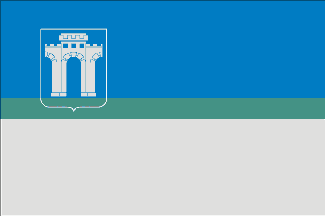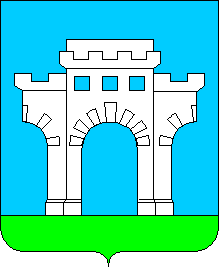 (2:3)
(2:3)from <www.city-adm.rv.ua>

Last modified: 2004-08-07 by dov gutterman
Keywords: rivne | rovno |
Links: FOTW homepage |
search |
disclaimer and copyright |
write us |
mirrors
 (2:3)
(2:3)
from <www.city-adm.rv.ua>
See also:
From the site of Ukrainian
Heraldry:
"The gonfalon was approved in 1993. It is a rectangular
canvas with a ratio of 2:3. It's divided horizontal into three
parts (dark blue, green, silver-white) with the ratio: 5:1:5. On
a distance of 1/3 from the staff there is a black-and-white coat
of arms of Rivne."
Phil Nelson, 7 July 1999
The flag at <www.city-adm.rv.ua>
is quite different in the posiotion of the Coat of Arms from the
one Reported at the Heraldry site.
Dov Gutterman, 27 July 2004
 (2:3)
(2:3)
from the site of Ukrainian
Heraldry

from the site of Ukrainian
Heraldry
"The modern emblem has been confirmed in 1990. In an
azure field there is an argent tower with entrances from three
sides. The tower stands on the vert ground."
Phil Nelson, 7 July 1999
From the site of Ukrainian
Heraldry:
"City in Rivne Oblast. The first mention refers to the
middle of the XIII century. The origin of the name comes from the
word "rivnyna".In the XV century Maria Nesvyts'ka
succeeded in getting the Magdeburg Right for the town from king
Kazymyr. It is known that a seal of those days had a picture of a
gate of a castle created by Nesvyts'ka."
Phil Nelson, 7 July 1999
My ancient encyclopedia says, under the heading
"Magdeburg", "Magdeburg became a flourishing
commercial town during the 13th century, and was an important
member of the Hanseatic League..."Magdeburg law"
(Magdeburger Recht), securing the administrative independence of
municipalities, was widely adopted." Perhaps where the
source says "was given Magdeburg right" we should
translate "received the right of civic self-government"
or something similar.
John Ayer, 8 July 1999
Formerly known as Rovno. In 'The Complete Guide to the Soviet
Union' by Victor and Jennifer Louis, 1991, p. 160: 'Local legend
gives an explanation for the origin of the town Rovno's name:
when it belonged to the Ostrogski family they are said to have
possessed 99 towns and then purchased this place so that they
could claim to have exactly 100 towns. The Russian word for 100
is 'rovno'... first mentioned 1282 in connection with a battle
between Prince Chorny of Cracow and the Lithuanian prince
Vitan...' Could "rivnya" in Ukrainian mean
"hundred"?
Jarig Bakker, 15 July 1999
I don't think so, especially because "one hundered"
is "sto" in both languages (looks like "cmo").
There must be some kind of confusion here: in russian rovno
(looks like "POBHO") means "equal to",
suggesting that Victor and Jennifer Louis got their legend quite
hastily. On the other hand, that a local legend
about an western ukranian toponym is related to the russian
language sounds quite fishy: one would expect polish, lithuanian,
ruthenian or german - apart from ukranian, naturally.
Antonio Martins, 15 July 1999
Well, the russian word for 100 is not
"rovno": it's "sto". "Rovno" means
"rounded" as is "round number" (probably with
the same indo-european root). This said, the legend still makes
sense. If it's trouthful or not, that's another issue...
Jorge Candeias,18 july 1999
The city was never known as Rivne before 1918, assuming it
draws from "rivnyna" (flat terrain, plains). Wrong. The
terrain is in fact rolling hills. Poles knew the city as Rowne,
Kievan Rusians (ancestors of both Ukrainians and Russians) used
"Rovno." Incidentally, if the name was some derivative
from "flat terrain", it would be "Rovnoe" in
Russian, not "Rovno" as it was.
Mikhail A. Molchanov, 8 Febuary 2001